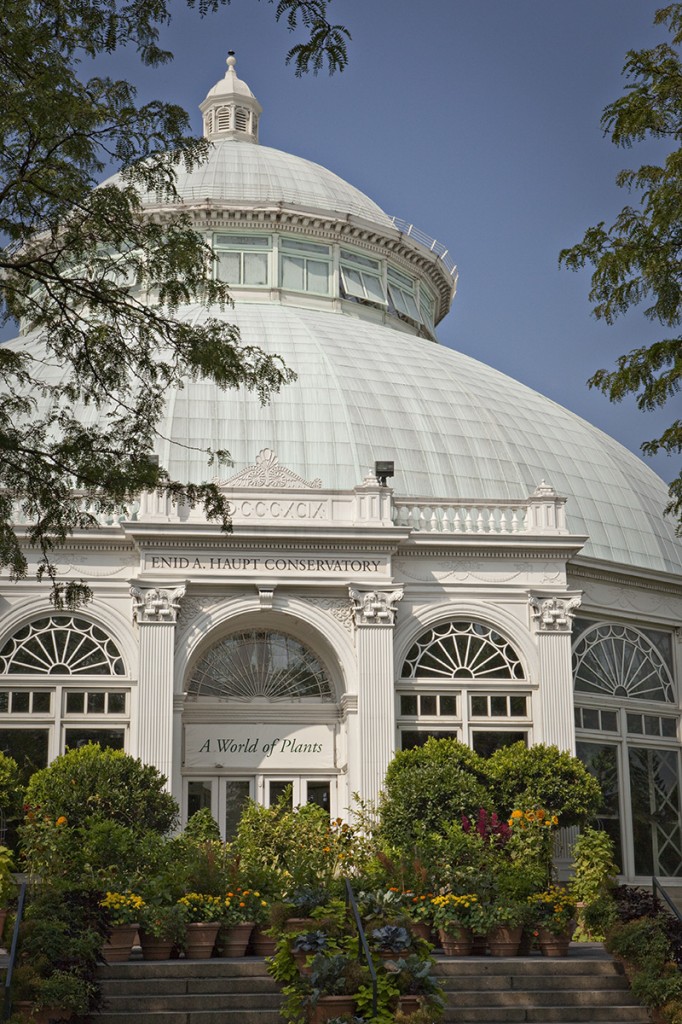Conservatory Container Garden Rich in Design, Edibles
Posted in Exhibitions, The Edible Garden on August 13 2010, by Plant Talk
Anything Goes—and Grows—in Potting Up Vegetables for Small Spaces
 |
Francisca Coelho is the Vivian and Edward Merrin Associate Vice President for Glasshouses and Exhibitions. |
 You may not be aware of this, but every plant you have grown in a pot, box, can, tub, or other vessel is an example of container gardening. Your potted houseplants, summer pots of annuals, and hanging baskets all represent gardening in containers. In the tropics where I grew up, people lined their front steps with many colorful, painted containers of every shape and size. They filled them with beautiful, tropical, flowering exotics and with plants used for food and medicine. Versatility is the hallmark of the container gardener!
You may not be aware of this, but every plant you have grown in a pot, box, can, tub, or other vessel is an example of container gardening. Your potted houseplants, summer pots of annuals, and hanging baskets all represent gardening in containers. In the tropics where I grew up, people lined their front steps with many colorful, painted containers of every shape and size. They filled them with beautiful, tropical, flowering exotics and with plants used for food and medicine. Versatility is the hallmark of the container gardener!
In front of the Enid A. Haupt Conservatory, as part of The Edible Garden, I am growing an assortment of tasty vegetables in containers. The design is simple-a mix of semicircles and straight lines with pots ranging in size from 14 to 36 inches in diameter.
The steps leading up to the elevated area are lined with pots filled with Tumbling Tom tomatoes, mammoth red cabbages, purple kohlrabi and kale, ornamental trailing sweet potato vines, and marigolds, included to ward off unwelcomed pests and to encourage hungry bees to pollinate my edible delights.
On the elevated section, I have placed the pots in straight lines to the sides and back and in semicircles in the center area so that you can stroll through this raised garden and learn about different food plants as you go. Here you will find recognizable vegetables like cherry tomatoes, hot peppers, eggplants, squashes, and corn, along with the more exotic-variegated lemons, bay trees, pigeon peas, sorghum, some unusual cucumbers, snake melons, bitter melon, and yard-long beans that provide food for people in faraway places like Africa and Asia.
There is also climbing spinach-did you know that spinach could climb? This plant, an exotic from Asia with edible leaves, does not bolt and lasts the entire season. The flowers are unique, small and pink, making the plant a good candidate for your summer annual border.
I planted sunflowers in many pots to provide vivid bursts of color from a distance. Yellow finches attracted to the developing seed visit this garden throughout the day and are a sight to see. Did you know sunflower seeds are one of the healthiest foods you can eat!
You can grow just about anything in a container. As a matter of fact, I think container gardening is more satisfying than growing directly in the soil. You will encounter fewer weeds and pests and you will have more control over growth and the overall health of your plants. Furthermore, you can show off your creative side by manipulating the plants as you wish.
Use containers that provide adequate depth to facilitate vigorous, healthy growth of your chosen plants. Begin with some knowledge about each plant’s specific cultural needs and then provide the following major requirements necessary for the health and productivity of all plants.
7 essential ingredients for successful container gardening
- Optimum temperatures: Most food plants grow well between 50 and 80 degrees F. This range covers cool weather crops such as lettuce and spinach as well as the lovers of warmth such as tomatoes, peppers, and eggplants.
- Adequate light: Many food plants like bright light to full sun; deep shade won’t do.
- Adequate humidity: Food plants thrive when the humidity is at least 60 percent.
- Well-drained, humus-rich soil: Food plants develop healthy, strong roots in soil that is rich in humus, compost, or manure and is well-drained to allow water and nutrients to penetrate.
- Proper watering: Do not let food plants dry out. As a rule, allow the top half of the pot to dry before re-watering, especially if your plants are deeply rooted.
- Controlled feeding: Vegetables need regular feeding to grow well. You can provide food in two ways-either in a slow-release form that allows the plants to acquire food at every watering, or by applying food in liquid form at every third watering. In either case, follow the directions on the manufacturer’s label to feed correctly.
- Good air circulation: When the air is stagnant, diseases creep in, so place your containers in an area where they can benefit from moving air.
I encourage you to come and visit the Conservatory Container Garden in front of the Haupt Conservatory. It changes daily as plants mature and the fruits are harvested. The Edible Garden runs through October 17. I hope to see you there.


This project at the garden is so wonderful to hear about – they have ignored urban gardening (even though they technically are) and still refuse to carry GARDEN YOUR CITY, the book I wrote about urban gardening! Well – at least you have “broken through” – CONGRATS!